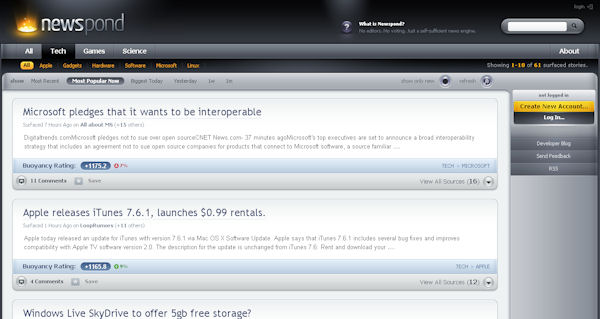Digmeme? Techigg? Dichmegg?
I’ll let you into a little secret: it’s not very difficult to become a technology journalist. In fact anyone can do it.
All you need to do is go on to the net, type a few keywords like ‘technology’ into Google and find out what everyone’s banging on about that day. A little bit of judicious editing to get round pesky copyright laws and off you go.
After a while you’ll see a few sites, like HEXUS.channel, cropping up on a regular basis and you might bookmark them and just go to them every time you want to know the news.
If you can’t be bothered to even access your bookmarks you might consider adding your shortlist of sites to an RSS reader (or aggregator) and then you’ll see a big list of all the stories your chosen sites have published since you last checked.
Of course there is a bit more to being a journalist than just recycling stories already in the public domain… THERE IS! But it’s always useful to be able to easily check what’s being written on the net.
Web 2.0
The ‘web 2.0’ evolution of this concept can be very simplistically subdivided into two categories: social bookmarking and memetrackers.
Social bookmarking involves an online community in which individuals submit stories they like and then the rest of the community indicate what they think of it. The more popular the story, the more prominently it’s displayed.
Typical examples of these are the little links you see tucked away in the corners of nearly every news story you see on the net these days and are called things like Digg, del.icio.us and Stumbleupon.
Memetrackers, by contrast, use clever things like maths and algorithms and other ways of more scientifically determining the most popular and significant story of the day. These are particularly effective at rooting out stories on smaller websites and blogs that might not get noticed otherwise. A favourite one of these for people interested in technology is Techmeme.
So when, last Tuesday (19th February), I was looking on Techmeme and saw the headlines: Is Newspond a Techmeme killer? Newspond: News Aggregator Extraordinaire, and What do you get if you cross Techmeme with Digg? I was intrigued. I contacted Newspond and co-founder Ian Reardon, who was kind enough to grant me an interview.
Next Big Thing?
It turns out that Tuesday was launch day so I start by asking
him why he decided to make Newspond. “I worked for five years as a software
engineer for a search company,” he explains. “I got tired of being in a cubicle
for eight hours a day so I decided to quit my job and study law.” As you do, and he still does.
Not content with the small matter of trying to qualify as a lawyer, he decided to collaborate with his friend Chan Karunamuni on Newspond, which has been three years in the making. Many people assumed they had identified this as a way to make a bunch of money creating the internet’s Next Big Thing and then selling it to Google or Microsoft or whoever for obscene amounts of cash. But Reardon insists that isn’t the case.
“We have no real plans commercially. We didn’t start it with a view to selling it on in a year or two and we haven’t really thought about how we can generate revenue from it. We just want to create something people want first, but obviously we’d like it to be as big as possible,” he says.
Amazingly, Reardon and Karunamuni are the only two people working on Newspond. Karunamuni appears to be the creative one, who is responsible for the site’s clean design and slick interface, while Reardon is the techie, who does all the behind-the-scenes maths stuff. This isn’t his first attempt to harness the power of the web, but his other project – myapartmentmap.com – has been on the back burner for a year or so.










